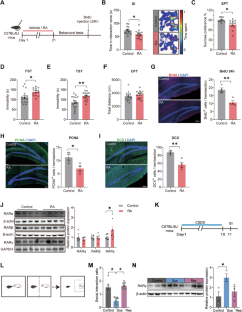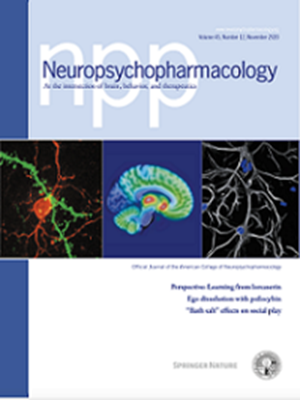Astrocytic RARγ mediates hippocampal astrocytosis and neurogenesis deficits in chronic retinoic acid-induced depression
IF 6.6
1区 医学
Q1 NEUROSCIENCES
引用次数: 0
Abstract
Accumulating clinical evidence indicates that chronic exposure to retinoic acid (RA) may lead to depressive symptoms and even increase the risk of suicidal behavior, which severely limits the clinical long-term application of RA. The exact mechanisms through which RA contributes to the onset of depression remain largely unclear. Here, we administered intraperitoneal injections of all-trans RA to male C57BL/6 J mice over a period of 21 days. Mice subjected to chronic RA exposure displayed depressive-like behaviors, accompanied by impaired hippocampal neurogenesis and heightened RA receptor gamma (RARγ) levels in the ventral hippocampus (vHip). The administration of an RARγ antagonist effectively mitigated these RA-induced neurogenesis impairments and depressive-like behaviors. Chronic exposure to RA was also observed to promote hippocampal astrocytosis and increase astrocytic Rarγ expression in the ventral dentate gyrus (vDG) of hippocampus. Notably, astrocytic RARγ in the vDG was found to be a key factor in the observed hippocampal astrocytosis and neurogenesis impairments, and depressive-like behaviors. Chronic exposure to RA resulted in increased extracellular glutamate levels in neural stem cells (NSCs), accompanied by a decrease in glutamate transporter 1 (GLT-1) expression. Enhancing astrocytic GLT-1 expression was found to alleviate both hippocampal astrocytosis and depressive-like behaviors caused by RA. These findings underscore the critical role of astrocytic RARγ-GLT-1 axis in the development of hippocampal astrocytosis, neurogenesis impairments, and depressive symptoms, suggesting that targeting RARγ-GLT-1 could potentially offer an effective therapeutic approach for depression.


星形胶质细胞 RARγ 在维甲酸诱导的慢性抑郁症中介导海马星形胶质细胞增生和神经发生缺陷
越来越多的临床证据表明,长期接触维甲酸(RA)可能会导致抑郁症状,甚至增加自杀行为的风险,这严重限制了维甲酸在临床上的长期应用。视黄酸导致抑郁症发病的确切机制在很大程度上仍不清楚。在此,我们给雄性 C57BL/6 J 小鼠腹腔注射全反式 RA,为期 21 天。长期暴露于RA的小鼠表现出类似抑郁症的行为,同时海马神经发生受损,腹侧海马(vHip)中RA受体γ(RARγ)水平升高。服用RARγ拮抗剂可有效缓解RA诱导的神经发生损伤和抑郁样行为。研究还观察到,长期暴露于RA可促进海马星形胶质细胞增生,并增加海马腹侧齿状回(vDG)中星形胶质细胞Rarγ的表达。值得注意的是,研究发现vDG中的星形胶质细胞RARγ是导致观察到的海马星形胶质细胞增多、神经发生障碍和抑郁样行为的关键因素。长期暴露于RA会导致神经干细胞(NSCs)细胞外谷氨酸水平升高,同时谷氨酸转运体1(GLT-1)表达减少。研究发现,提高星形胶质细胞GLT-1的表达可减轻RA引起的海马星形胶质细胞增多症和抑郁样行为。这些发现强调了星形胶质细胞RARγ-GLT-1轴在海马星形胶质细胞增多症、神经发生障碍和抑郁症状的发展过程中的关键作用,表明以RARγ-GLT-1为靶点有可能为抑郁症提供一种有效的治疗方法。
本文章由计算机程序翻译,如有差异,请以英文原文为准。
求助全文
约1分钟内获得全文
求助全文
来源期刊

Neuropsychopharmacology
医学-精神病学
CiteScore
15.00
自引率
2.60%
发文量
240
审稿时长
2 months
期刊介绍:
Neuropsychopharmacology is a reputable international scientific journal that serves as the official publication of the American College of Neuropsychopharmacology (ACNP). The journal's primary focus is on research that enhances our knowledge of the brain and behavior, with a particular emphasis on the molecular, cellular, physiological, and psychological aspects of substances that affect the central nervous system (CNS). It also aims to identify new molecular targets for the development of future drugs.
The journal prioritizes original research reports, but it also welcomes mini-reviews and perspectives, which are often solicited by the editorial office. These types of articles provide valuable insights and syntheses of current research trends and future directions in the field of neuroscience and pharmacology.
 求助内容:
求助内容: 应助结果提醒方式:
应助结果提醒方式:


